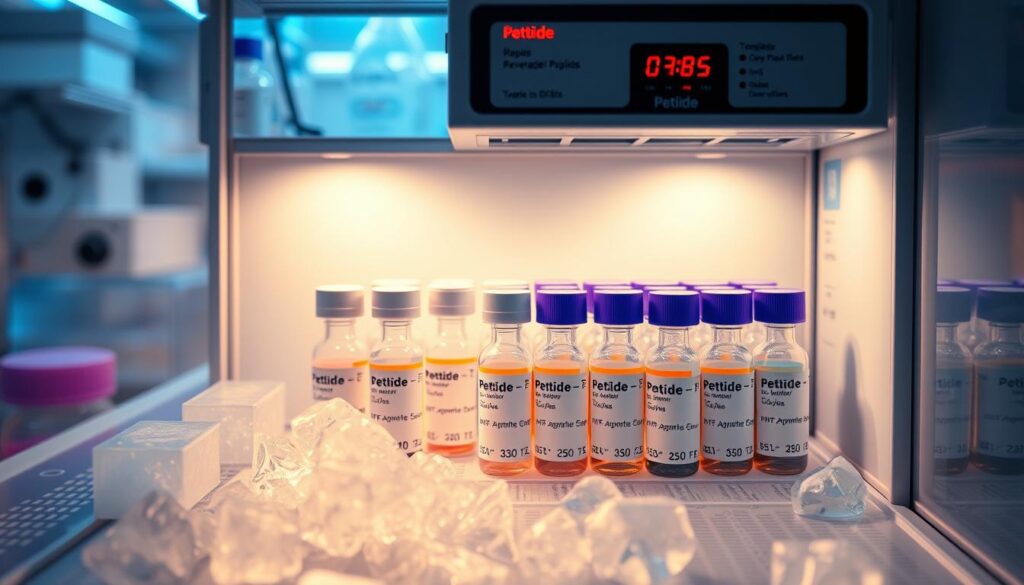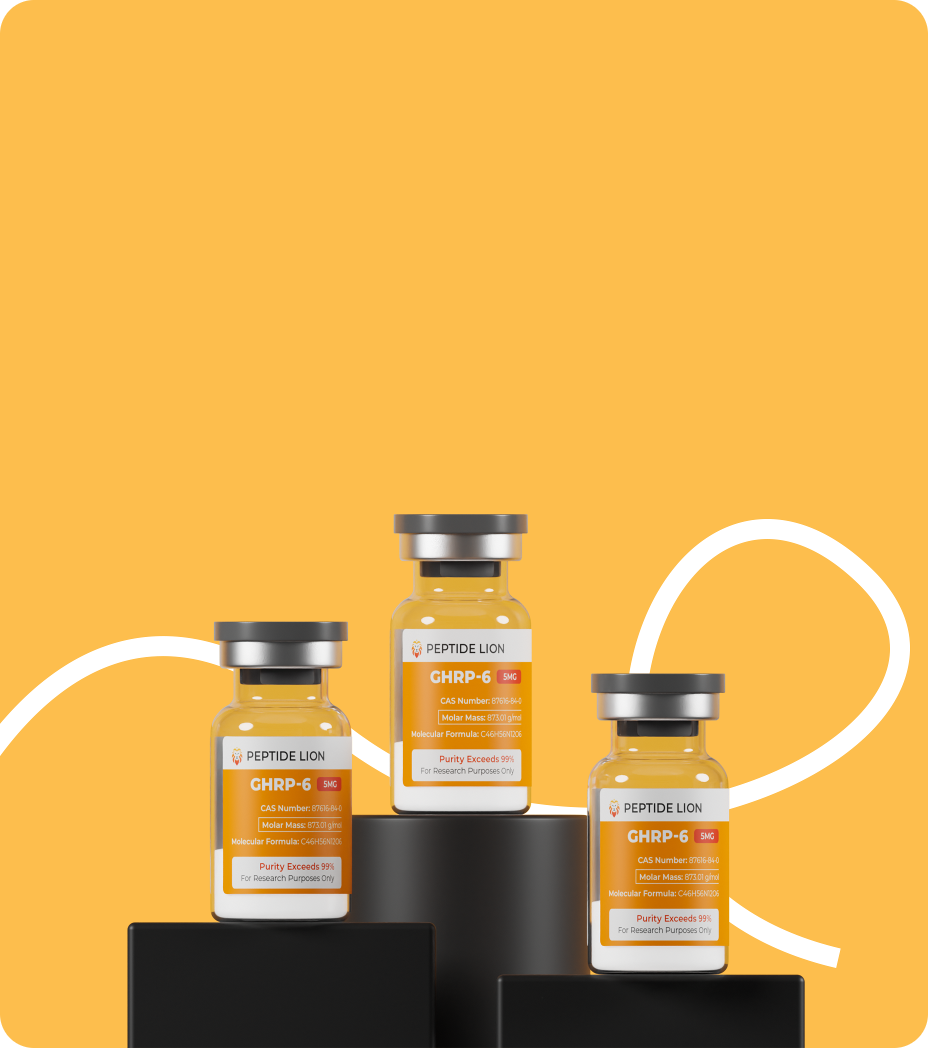Peptide storage Keeping your peptides in top shape is key to getting the most out of them. This guide will teach you how to store peptides correctly. You’ll learn how to keep them potent, pure, and lasting longer. By using these tips, you’ll be able to meet your fitness, health, and longevity goals.
Key Takeaways
- Proper peptide storage is essential for maintaining the stability and effectiveness of these powerful compounds.
- Understanding the nature of peptides and the factors that affect their stability is crucial for effective storage.
- Optimal storage conditions, including temperature, humidity, and light exposure, can significantly impact the shelf life and performance of your peptides.
- Implementing best practices for peptide storage can help you maximize the potency and longevity of your peptide supplements.
- Following this ultimate guide will empower you to store your peptides for peak performance and longevity.
The Importance of Proper Peptide Storage
Peptides are delicate biomolecules that need careful storage. Knowing their unique properties is key to keeping them stable. This includes their chemical makeup and how they react to their environment. We’ll explore how temperature, humidity, and light affect their stability.
Understanding the Nature of Peptides
Peptides are made of amino acids linked in a specific order. This makes them prone to degradation in bad conditions. Temperature, pH, and enzymes can all break them down, reducing their effectiveness.
Factors Affecting Peptide Stability
- Temperature: Peptides degrade quickly at high temperatures. Keeping them at low temperatures is crucial.
- Humidity: Too much moisture can break down peptide bonds. It’s important to store them in a controlled humidity environment.
- Light Exposure: UV and visible light can damage peptides. It’s essential to protect them from light exposure.
| Stability Factor |
Impact on Peptides |
Recommended Storage Conditions |
| Temperature |
Rapid degradation at high temperatures |
Low temperatures, typically -20°C or below |
| Humidity |
Hydrolysis of peptide bonds leading to degradation |
Controlled humidity, typically 30-50% |
| Light Exposure |
Oxidative damage and alteration of peptide structure |
Protect from direct light exposure, store in dark containers |
By knowing these peptide stability factors, you can store your peptides properly. This ensures their potency and purity, making them last longer and work better.
The Ultimate Guide to Storing Peptides for Peak Performance and Longevity
Getting the most from your peptide supplements is not just about quality. Storing them right is key to keeping them potent. This guide will show you how to store peptides to keep them effective over time.
Temperature is a big deal for peptide storage. They need to be cool, between 2°C and 8°C (35.6°F and 46.4°F). Heat can break them down, making them less effective.
Humidity matters too. Store peptides in a dry place, below 30% humidity. Too much moisture can damage them, making them less potent.
Light is another enemy of peptides. UV and visible light can start chemical reactions that harm them. Use dark or amber containers to protect them.
The right containers are important. Use borosilicate glass or high-quality plastic like polypropylene or polyethylene. These materials are less reactive and better protect your peptides.
Labeling and monitoring your peptides are also key. Label each container with the peptide’s name, concentration, and storage date. Check them often for any signs of damage, like color changes or cloudiness.
| Best Practices for Peptide Storage |
Recommended Conditions |
| Temperature |
2°C to 8°C (35.6°F to 46.4°F) |
| Humidity |
Below 30% relative humidity |
| Light Exposure |
Protect from UV and visible light |
| Storage Containers |
Borosilicate glass or high-quality plastic (polypropylene or polyethylene) |
| Labeling and Monitoring |
Clearly label samples and regularly check for signs of degradation |
By following these storage tips, you can keep your peptides potent and pure. This ensures they work well for a long time. Invest in good storage to maximize your peptide supplements’ benefits.

Conclusion
Storing peptides right is key to keeping them effective and lasting longer. Knowing how these biomolecules work and what affects them helps you store them well. This way, you keep your peptides potent and pure.
By following the tips in this guide, you can store your peptides to support your health and fitness goals. This unlocks the full power of these compounds.
The peptide storage summary shows how important it is to store them in the right conditions. This includes keeping the right temperature, avoiding light, and controlling moisture. Following these steps helps your peptides stay effective and last longer.
Storing your peptides well is an investment in your health and performance. This guide has given you the knowledge to protect your peptides. It helps you reach your fitness and wellness goals with confidence.
Adopting these storage tips means you’re looking after your future health and performance. Use this knowledge to make the most of your peptides. Enjoy a healthier, more vibrant life ahead.
FAQ
What are the key factors that affect peptide stability during storage?
Peptide stability can be affected by several factors. These include temperature, humidity, light, and the storage container type. Keeping the right storage conditions is key to keeping your peptides potent and pure.
What is the ideal temperature range for storing peptides?
The best temperature for storing peptides is between 2-8°C (36-46°F). For longer storage, a freezer can be used. But, it’s not always needed for short-term storage.
How does humidity affect peptide stability?
Humidity greatly affects peptide stability. The best storage environment has a relative humidity (RH) of 30-50%. High humidity can cause peptides to degrade, so a climate-controlled setting is best.
What types of storage containers are best for peptides?
For storing peptides, use glass or polypropylene vials or tubes. These protect peptides from light and prevent container interactions. Make sure containers are tightly sealed to avoid moisture and air.
How should peptides be labeled for proper storage and traceability?
Proper labeling is essential for peptide storage and tracking. Each sample should have its name, concentration, and preparation date labeled. This helps manage your peptide inventory and ensures correct use.
How often should I check on my stored peptides?
It’s important to regularly check your stored peptides. Look for signs of degradation like color changes or precipitation. Also, test their purity and potency, especially for long-term storage.






